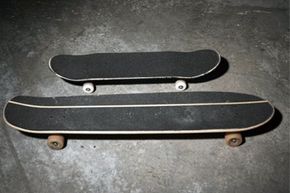If you've ever pondered ways to cut down on your routine expenses and shrink your carbon footprint, then perhaps you've considered longboarding as an alternative mode of transportation. Longboarding, a skateboarding subculture, can be an exhilarating way of exercising your balance and reflexes, but it's also perfectly suitable for getting you from point A to point B in an economically conservative and environmentally friendly manner. And the 750,000 or so enthusiasts in the United States, from fearless teens to decidedly more careful adults, swear that it's fun, too [source: Krcmar].
Longboarding was originally conceptualized in the early 1960s as a way to replicate the experience of surfing or downhill snowboarding but on paved surfaces instead of snowy or watery ones. The sport turns any piece of sloped pavement into the rider's own personal amusement park. Unlike shorter skateboards or "shortboards," longboards aren't ideal for doing the impressive ollies and railslides that win the hearts and minds of skateboarding enthusiasts, although, if you really wanted to, you could try those tricks with a longboard.
Advertisement
Instead, longboards are built for fast, stable rides. Their wheels, which are comparatively softer and larger than those of a skateboard, enable the rider to turn more easily than a regular skateboard allows. The longer deck, or platform that you stand on, gives riders more stability, which is nice when you're trying to avoid eating more concrete than necessary. Together, the wheels and the deck make longboards more suitable for transportation than their shorter counterparts.
In this article, we'll dig deeper into what sets longboards apart from other skateboards, how to make the most of a longboarding outing and how to adjust your longboard to best accommodate your own riding preferences.
Keep reading to learn more about the physics of longboarding.
Advertisement





